Audi and BMW offer midsize sedans with 3.0-liter six-cylinder diesel engines. Mercedes-Benz used to offer its midsize sedan with such an engine (and still does in Europe, where about half the cars sold are so powered). But among the revisions for the 2014 E-Class Mercedes has opted to offer a 2.1-liter four-cylinder diesel instead of a 3.0-liter V6. Does this engine deliver the performance and refinement expected in a fairly heavy luxury sedan? Is there enough of a fuel economy payoff? And how much has the rest of the car improved for 2014?
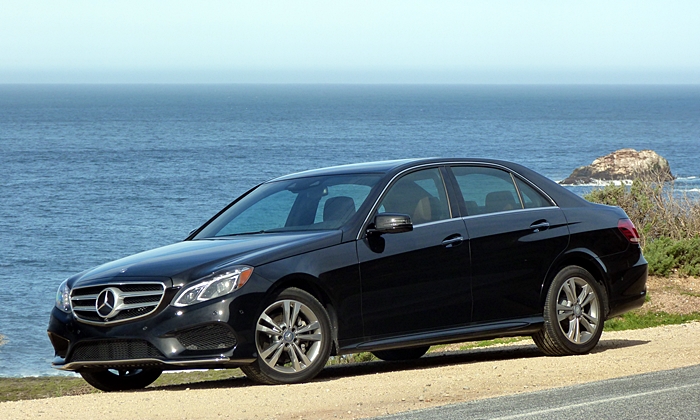
As conventional as sedan styling gets lately, but many people find the 2014 E-Class quite handsome. more E-Class photos
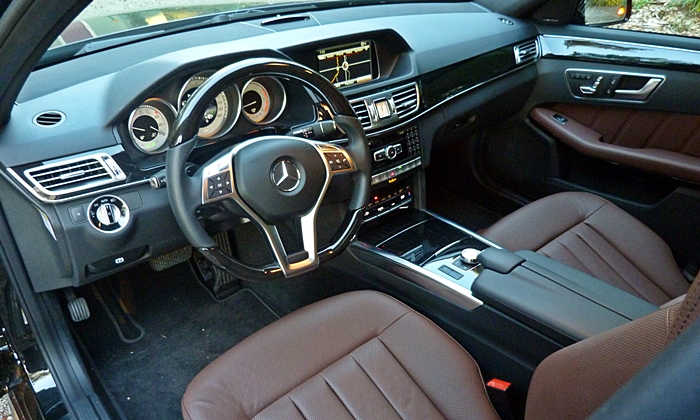
My photos don't do this interior justice. It looks and feels more luxurious than the others.
| |
Compared to the 5-Series |
| Brand reputation & image |
 Better
Worse
Better
Worse
|
I tend to ignore brand reputation and image, and this is reflected in my reviews. But there's just no way to ignore that a Mercedes is a Mercedes. Audi and BMW now command similar prices, but haven't yet acquired the same mystique. They probably never will for people born before 1980.
This mystique cuts both ways. The three-pointed star makes too strong a statement for some people.
| Fuel economy |
 Better
Worse
Better
Worse
|
The latest diesels tend to be much smoother, quieter, and more powerful than those of just a few years ago. But people still don't buy them for their smoothness, quietness, or quickness. Gas engines maintain a lead in these areas. People buy diesels for fuel economy, and here the Mercedes-Benz E250 BlueTEC excels. Its EPA numbers are best-in-class: 28 mpg city and 42 mpg highway with rear-wheel-drive (RWD) and 27/38 with all-wheel-drive (AWD). Even in E400 Hybrid form the gasoline V6 in the E-Class manages only 24/30. The Audi A6 TDI, offered only with AWD, scores significantly lower than the E250 in city driving: 24/38. The BMW 535d splits the difference in city driving, but runs with the Audi on the highway: 26/38 with RWD and 26/37 with AWD.
So, based on the EPA numbers, the Mercedes has a significant fuel economy advantage, especially on the highway. Combine the EPA figures with a 21 gallon fuel tank, and the E250 BlueTEC can cover up to 900 miles between fill-ups. (This is especially attractive when you consider the sliminess of diesel fuel. Even much more than with gas, which largely evaporates when not contained, you do not want to spill any diesel on you or your clothing.)
Switching to the real-world numbers reported by the cars' trip computers, the Mercedes (tested with AWD) retains a clear edge over the Audi on the highway, where the trip computers reported 45 and 38, respectively. In suburban driving with a light right foot the results were closer, about 40 to 37. I did test the Mercedes in the Bay Area of California, rather than back home in Michigan. On my usual suburban route it probably would have managed a few more miles per gallon. Also add two-to-three mpg for RWD rather than AWD.
Most of my driving in the E250 was done along the scenic California coast, where a leisurely drive with infrequent stops but plentiful hilly curves netted 37 mpg on the way south and 41 on the return. Quite good for a fairly heavy all-wheel-drive luxury sedan--but the Audi (based on similar driving in an A7 TDI) would have been close.
The real challenge comes from BMW. In my suburban driving the 535d's trip computer reported from 37 to 47, with low 40s typical. On one highway drive it reported an astounding 53.8 (but on another a mere 38). The tested 535d was RWD. Even so, if both trip computers were similarly accurate the BMW could be about as efficient as the Mercedes in real-world driving, while being considerably more powerful.
Also, the 535d isn't the only BMW diesel sedan available in North America. If you can live with less interior space and less power, the Bavarians also offer the 328d (compared to the E250 here). The much lighter, four-cylinder car achieves EPA ratings of 32/45 with RWD and 31/43 with AWD, suggesting a clear advantage in city and suburban driving if not on the highway.
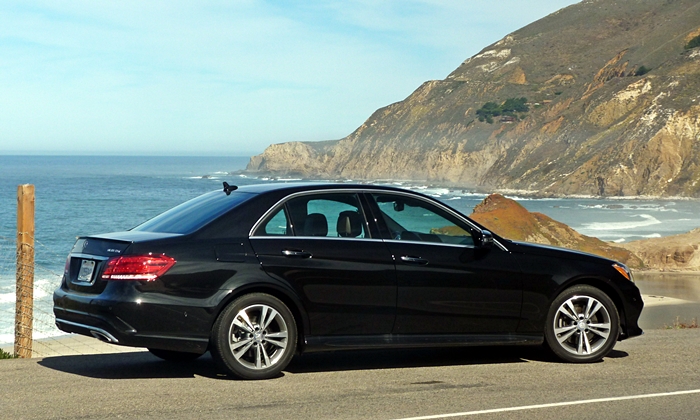
Among the changes for 2014, the rear fender lost a frumpy bulge.
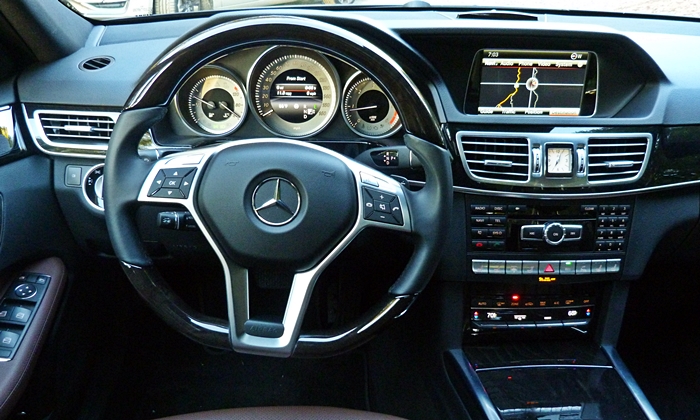
Controls aren't as complicated as they appear. Options include a flat-bottomed steering wheel.
| Ride smoothness |
 Better
Worse
Better
Worse
|
Spending a week each with the Audi and the BMW really brought home the greatest strength of the Mercedes. With their more aggressively tuned suspensions, the competing sedans don't ride as supplely as the Mercedes-Benz E250. On less than perfect road surfaces either can feel overly firm. Even in Sport form the E250 hardly ever does.
It probably helps that the E250 is only offered with 17-inch tires, even if these (unlike those on the E350, E550, and E63 AMG) are the run-flat sort so often criticized for their ride quality. The Audi and BMW are typically fitted with larger, heavier wheels and their attendant lower profile tires, run-flats on the latter. (The tested Audi A7 TDI rode on 20s, and the tested BMW 535d on 19s.) But it's not only a matter of wheels and tires. The suspension design and tuning in the Mercedes better filters out small bumps and divots.
The Audi also seems considerably less quiet inside than the other two. So quietness can also be a reason to buy the Mercedes, though the BMW has an edge in this area when driving on concrete.
The Mercedes engine has more diesel clatter at idle and low speeds than the Audi's, but it's a match for the BMW six despite being down two cylinders. Compared to the diesel four in the BMW 328d, the E250's engine sounds and feels far more refined. Auto stop / start means that the engine doesn't spend much time idling, anyway.
| Driving position & visibility |
 Better
Worse
Better
Worse
|
Even compared to the Audi A6 and BMW 5-Series, neither of which is especially swoopy, the Mercedes-Benz E250 has upright, squared-off, thoroughly conventional styling. I'm tempted to put exterior styling among the reasons not to buy the car, but many people find the unapologetically sedanish three-box profile quite handsome.
Whatever one's opinion of the E250's exterior shape, there's no denying that it pays big dividends in driving position and outward visibility. Especially compared to the BMW, you sit well above the instrument panel even with the driver seat in its lowest position. The windshield it set at a comfortable distance and angle, and the pillars flanking it are thin by current standards. It's also relatively easy to view what's going on beside and behind the car. If this isn't enough, an excellent around-view camera system actually makes parking the car not only easy but fun.
| Interior styling |
 Better
Worse
Better
Worse
|
Some people find the ambiance inside the BMW 535d overly severe, and that inside the A6 overly spartan. (Granted, others will find the Audi's interior the most tasteful of the bunch.) For luxury car buyers with relatively traditional tastes, the glitzier interior of the Mercedes looks and feels the most upscale and luxurious in this well-finished threesome.
| |
Compared to the 5-Series |
| Price or payments |
 Better
Worse
Better
Worse
|
If exterior styling is excluded from the reasons not to buy the Mercedes-Benz E-Class (see earlier note under Driving Position and Visibility), then this becomes a very short list. Pretty much just the car's lofty price. And maybe not even the price, if one compares other diesel-powered midsize luxury sedans. The E250 BlueTEC's $52,325 starting price ($54,825 with AWD) is well below the Audi's $58,395 and the BMW's $57,525. The Mercedes has fewer features standard, though. Similarly load the cars up, which can push the E250's price over $70,000, and the BMW is about $8,000 more expensive but the Audi (depending on the specific configuration) can come in a little lower.
As with fuel economy, the real pricing challenge comes from the smaller, less everything-but-handling 328d. Similarly equipped, the compact BMW lists for about $10,000 less than the midsize Mercedes-Benz.
Another way to look at the pricing of these cars: how much more does the diesel cost? The E250 is actually the least expensive E-Class, undercutting the E350 by $500. With the Audi A6, the 3.0 TDI costs $2,400 more than the 3.0T and $8,000 more than a similarly equipped 2.0T. The 535d costs $1,500 more than the 535i and $5,650 more than the 528i even after adding leather to the latter. And a 328d costs $1,300 more than a 328i and $3,880 more than a similarly equipped 320i.
So, only with the Mercedes will you pay less rather than more (even much more) for the diesel. You just have to be willing to overlook the E250's cylinder count for this to seem a bargain.
| |
Compared to the 5-Series |
| Safety & braking |
 Better
Worse
Better
Worse
|
The Mercedes-Benz E250 BlueTEC's price can go from the low 50s to the low 70s because nearly all of the latest and greatest features are available on the car following the 2014 revisions. Many of these features focus on safety. The Lighting Package ($1,500) now includes LED headlights instead of Xenons. And the Driver Assistance Package ($2,800) can now nearly drive the car. I initially did not realize that activating the all-speed adaptive cruise control also activated the lane keep assistance system. My first clue: while driving down the highway the steering seemed to have a mind of its own. Unlike most other such systems, which wait until the car is nearing or has even crossed the dividing line, the latest Mercedes-Benz system tries to keep the car in the center of the lane, and does this quite well. If you take your hands completely off the steering wheel for an extended period of time the system will start sounding a warning and flash a pair of red hands in the instrument cluster. The system isn't foolproof, and Mercedes doesn't want owners to feel they can just let the car drive itself. As a safety rather than a convenience feature, though, this package should significantly reduce accidents due to driver inattention.
If an accident occurs despite these safety systems, the 2014 E-Class is among the most crashworthy cars you can buy. Due to its combinations of effective collision prevention systems and an extremely strong body structure (which in traditional Mercedes fashion oozes solidity), the sedan has earned a top safety rating from the IIHS.
| Front seat support & comfort |
 Better
Worse
Better
Worse
|
The reviewed car also included the "Active Multicontour Driver Seat," and I found this feature easily worth the $660 it adds to the price of the E-Class. The side bolsters aren't only adjustable (as they are with the "multicontour" seats in the BMW), but the one on the outside can be set to automatically squeeze inwards when the steering wheel is turned. Though rather silly in a parking lot (the programming should take vehicle speed into account), this squeeze is reassuring, even encouraging, when flogging the car along a twisty road. Meanwhile, you can be receiving one of four levels of massage (slow and gentle, slow and vigorous, fast and gentle, or fast and vigorous).
Note that the option is for the driver seat. The front passenger seat, while also very comfortable, does not get these features. This could strain some marriages.
The multi-adjustable seats in the BMW 5-Series don't include dynamic bolsters, but they do include a separately adjustable upper seatback. Of greater importance for some buyers: both front seats include the full array of adjustments. Pricing is $1,300 with just the power adjustments, or $2,400 for these plus ventilation and massage. Adjustments notwithstanding, the Mercedes seats might have a slight edge in comfort.
The Audi A6's front seats aren't available with more than basic adjustments plus four-way power lumbar, and they're also harder and less comfortably contoured than the seats in the other two cars. This said, during and after a 600-mile drive in an A7 TDI I felt absolutely no discomfort. So while the Audi's seats don't feel especially comfortable or luxurious, they do provide proper support.
Moving to the rear seats, all three sedans provide a decent amount of room and comfort for adults. The cushions should be a little higher for thorough thigh support, but this is typical of midsize sedans.
The E-Class has less trunk space than the 5-Series (16.4 vs. 18.4 cubic feet), but more than the A6 (14.1 cubic feet). A split folding rear seat is a $440 option.
Sadly, while Merecedes-Benz continues to offer an E-Class wagon, they don't offer said wagon with a diesel engine in North America. If you do happen to want a diesel-powered station wagon, and you live in the U.S. or Canada, then the BMW 328d is your only option. Unless a hatchback will do; then Audi offers the stylish A7 TDI and Porsche offers the not-so-pretty but sportier handling Panamera Diesel.
| Handling |
 Better
Worse
Better
Worse
|
Okay, so the E250's optional driver seat provides excellent support in hard turns. But is there any point in driving the car quickly along a curvy road?
When I tested the 2013 Mercedes-Benz E550, I found it clumsy and overly prone to plowing despite the presence of a firm-riding sport suspension. So I was pleasantly surprised when the 2014 E250 BlueTEC tackled the curves of the California coast with delightful, confidence-inspiring poise and balance. Apparently the suspension tweaks made with the other revisions for the 2014 model year were beneficial ones. Despite steering that remains overly light for aggressive corner carving and perhaps a bit less body control than in the more tautly suspended BMW, I greatly enjoyed driving the Mercedes.
Or maybe I don't dislike light steering as much as I think I do. It's partly responsible for the E250's relatively light, agile feel. The car's smaller, and therefore lighter, wheels also contribute. In comparison, the Audi and the BMW feel considerably heavier even though they are not. "Musclebound" came to mind when driving the latter around the suburbs. The 535d will outperform the other two when pushed, hence the slightly higher score in this category, but it never stops feeling much larger and heavier than the Mercedes, and in daily driving it often feels stiff and unwieldly.
| Powertrain performance |
 Better
Worse
Better
Worse
|
If you want a brutally quick midsize sedan, Mercedes will gladly sell you an E63 AMG with a 577-horsepower supercharged 5.5-liter V8 engine. With the E250 and its 195-horsepower 2.1-liter four-cylinder engine (turbocharged like nearly all modern diesels), the focus is clearly on fuel economy rather than performance. Yet in typical everyday driving, or even some spirited hustling through the hills south of Palo Alto, the small diesel motivated 4,409 pounds of midsize luxury sedan surprisingly well.
As diesel fans will tell you (and tell you again, and again), the key is torque--the amount of force exerted on the engine's output shaft per revolution. Diesels cannot rev as high as gasoline engines, so liter for liter they cannot produce nearly as much peak power. But how much of your driving is done with the engine spinning more than 4,000 rpm? At lower engine speeds, diesels are stronger than gas engines, and that in the E250 is especially torquey for its size. While the 2.0-liter in the 328d manages 280 lb-ft of torque (20 more than the gasoline turbocharged 2.0-liter four in the 328i), the 2.1-liter in the E250 twists out 369. This isn't quite a match for the 3.0-liter sixes in the A6 TDI (240 hp, 428 lb-ft) and 535d (255 hp, 413 lb-ft), but it's much closer than the 43 percent difference in size might suggest. It's also far more torque (and thus midrange power) than you'll find in a Mercedes-Benz E350 (302 peak horsepower but 273 lb-ft of torque).
What this means in practice: a gentle squeeze on the E250's accelerator unleashes a surge in power easily sufficient for nearly any challenge posed by daily driving, including merging onto a freeway and passing on a two-lane road. You'll rarely feel like you're working this engine hard, and you'll often feel like you're barely working it at all. Very impressive for a powerplant of its size, much less one powered by diesel fuel.
The four-cylinder diesel in the 328d might be even more efficient, but this advantage largely stems from the compact BMWs much lower curb weight. Also, the BMW four isn't nearly as strong or nearly as smooth and quiet. As noted earlier, the strongest challenge to the E250's engine comes from the 3.0-liter six-cylinder in the 535d. Thought not quite as refined as the similarly sized engine in the Audi, the BMW six might match the efficiency of the E250 in real world driving despite being the strongest of the bunch. While the E250 can get from a dead stop to 60 mph in under nine seconds with no special tricks, the 535d can perform the same task in just over six seconds. Such strong acceleration might not be a huge surprise given the BMW engine's size. The huge surprise is that the same engine is also capable of over 40 mpg. Just don't expect strong acceleration and impressive fuel economy simultaneously. Push either car hard, and fuel economy will sink well below 30 mpg.
It might seem foolhardy, fitting the E-Class with a 2.1-liter four-cylinder diesel when Audi and BMW field 3.0-liter sixes. But the small engine delivers the performance and refinement people expect in a midsize luxury, plus outstanding fuel economy, especially on the highway.
Does the BMW manage about the same fuel economy in the real world, plus quicker acceleration? Perhaps. A much more systematic and thorough evaluation would be needed to confirm or deny the efficiency part.
This question aside, the Mercedes engine can deliver all the performance the great majority of buyers will ever need, in a car with a more welcoming interior, sprightlier handling, and the latest safety options. If you also happen to find its exterior handsome, the Mercedes-Benz E250 BlueTEC could be that ellusive thing, the perfect car--if you can afford it.
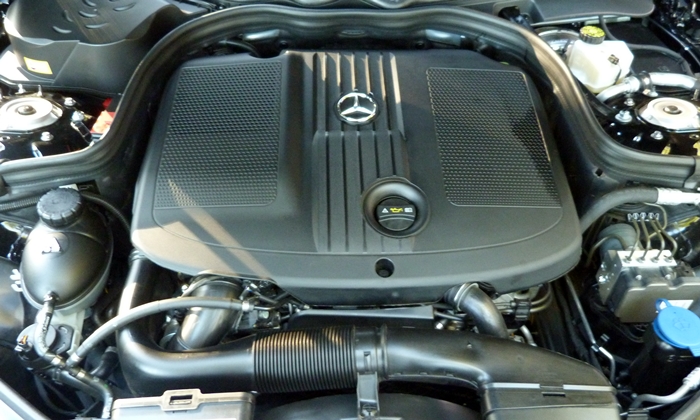
The little engine that could.
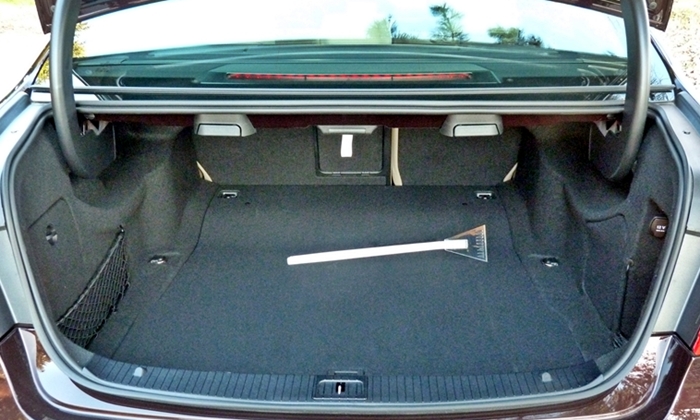
Trunk capacity also competitive, if a few cubes tighter than in the BMW. Folding seat an option.
See more 2014 Mercedes-Benz E-Class photos
Mercedes, Audi, and BMW each provided an insured car for a week with a tank of fuel.









